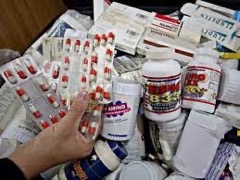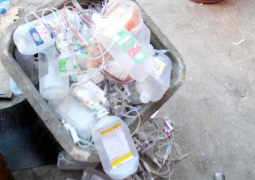
The first story is one of a slow, agonizing death. A 58-year-old grandmother, living alone with hypertension and diabetes, relies on her children in the USA to send money each month for her essentials: food, shelter, and medications. Faithfully, she takes her prescribed metformin 500mg to control her blood sugar and lisinopril 40mg to manage her blood pressure, purchased by a neighbor from the local drug store. Unbeknownst to her, the medications are counterfeit, containing only 100mg of metformin (20% of the stated amount) and a mere 2mg of lisinopril (5% of the stated amount).
Without access to primary care or routine monitoring, such as A1c tests or daily blood pressure checks, the grandmother attributes her worsening symptoms to the scorching Saharan heat and the emotional toll of losing friends. Her children, reassured by her adherence to medication, are stunned when they receive the call that she has suddenly passed away from a stroke. The true culprit? Prolonged exposure to counterfeit drugs that failed to control her blood pressure and blood sugar.
The second story is one of a fast, cruel death. A single mother of four, widowed by her husband’s premature death at 48 from kidney failure caused by undiagnosed diabetes, finds herself in a desperate situation when her 2-year-old child develops a persistent fever. Acting on a friend’s advice, she purchases children’s ibuprofen from the village drug store and administers two spoonsful to her child in an attempt to subdue the fever. Within hours, her child becomes violently ill, and by the time she makes the 3-hour trek to a regional health center, it is too late. Grief strikes again as her child becomes one of many innocent lives claimed by a harmful ingredient in a lawfully registered and distributed medication.
How big is the problem?
The United Nations Office on Drugs and Crime estimates that nearly half a million people in sub-Saharan Africa fall victim to counterfeit medicines each year. The 2023 report ‘Trafficking in Medical Products in the Sahel’ indicates that 19-50% of medical products in the region are falsified or substandard. Between 2017 and 2021, over 605 tons of questionable medical products were seized in West Africa alone. Africa accounts for an astounding 40-50% of the world’s substandard medications, with an estimated 1 in 2 drugs failing to meet quality control standards upheld in Western countries.
Counterfeit drugs pose two primary dangers: they may contain little to none of the active ingredient, rendering them ineffective, or they may include harmful inactive ingredients, such as anti-freeze. Manufacturers of these substandard products intentionally exploit nations with a high amount of poor and inadequately educated citizens, weak regulatory environments, and insufficient laboratory infrastructure for quality control.
To fully understand the scope of the problem, it is essential to recognize that any product manufactured in a lab and considered a medicine or substance with a physiological effect when ingested or introduced into the body falls into two main categories. The first category is prescription medications, such as antibiotics for infections or drugs for chronic conditions. The second category is over-the-counter medications, which often pose lesser harm when used without the guidance of a trained clinician, such as pain relief agents like ibuprofen and paracetamol, cough medicines, and a plethora of vitamins and supplements. Increased access to these medications, often manufactured outside the continent, puts Africa at significant risk, as evidenced by the paracetamol syrup incident.
The fact that the majority of medications consumed in Africa are not produced on the continent has two major implications. Firstly, African countries will always be at the mercy of manufacturers who recognize the size and vulnerability of the African market, particularly in terms of the limitation of human capacity and financial resources for robust oversight and internal surveillance. These manufacturers may exploit the system to maximize profits, even if lives are lost as collateral damage. Until African nations can manufacture and trade medications freely with each other, this problem will persist.
Secondly, many regulatory frameworks across sub-Saharan Africa were originally designed to prioritize exclusivity and market access rather than focusing solely on ensuring the quality and safety of products from the point of origin (manufacturers & distributors that have access to our consumers). One can argue that most of these frameworks are outdated and not concurrent with the current state of the global drug supply chain, which involves sophisticated marketplaces serving nations that, for the most part, have insulated their consumers beyond the point of questioning the authenticity of medications.
After all the work usually done from a clinical standpoint to determine what is wrong with a patient and provide them with a solution/instruction on what to take to cure or manage their condition (a prescription, or Rx, is essentially a solution), there is still one wildcard out of the patient, prescriber, and often pharmacist’s control: is this medication even the real thing?
It’s no wonder that the local herbalist who advertises on radio and in markets, claiming to heal all things but death, poses as a formidable competitor to modern medicine. The chance that patients are getting the genuine article and experiencing the actual positive effect is essentially a coin flip. It’s human nature to seek alternatives when it appears that “garab bi toubabi” (the white man’s medicine) doesn’t work. In reality, the medication may simply be counterfeit. Ironically, most “modern medications” are derived from plants, but that’s a topic for a separate article.
It is important to acknowledge that historically, protecting the financial interests of manufacturing companies has been a complex issue requiring a balanced approach. Sustainable business models are necessary to ensure the continued development and availability of essential medicines and food products. However, with the rate of new drug development drastically slowing down, business viability, manufacturing, and exporting prowess should never come at the cost of compromising public health and well-being.
How Drugs actually come to market?
It is crucial to understand the process by which new drugs come to market. The journey from drug discovery to market approval is highly rigorous and has a low success rate. Typically, only 10-20% of drugs that begin preclinical testing make it to clinical trials, and a mere 5-10% of those are eventually approved by regulatory agencies like the U.S. Food and Drug Administration (FDA). The overall success rate from initial discovery to approval is a staggering 1-2%.
Once a drug is approved, it is given a true chemical or generic name, such as “acetaminophen” or “sildenafil.” The marketing department then develops a brand name, like “Tylenol” or “Viagra,” to appeal to consumers. In most markets, such as the United States, the manufacturer is granted a 20-year patent and exclusive distribution rights to recoup investments and fund future research.
Interesting sidenote: the discovery of sildenafil, the active ingredient in Viagra, was accidental. Initially studied as a treatment for a heart condition called angina, researchers discovered during clinical trials that male participants reported improved erections as a side effect. This serendipitous finding prompted a shift in focus to investigating sildenafil’s effectiveness in treating erectile dysfunction. It was up, up, and away from there! Viagra’s sales skyrocketed up to $1.6 billion in sales for U.S manufacturer Pfizer between 1998 and 2016 alone.
It is also noteworthy that drug (generic/chemical) names are not randomly assigned but are codified based on the last 4 to 5 letters, which indicate the class of medication or family of drugs they belong to based on their therapeutic indication. For instance, a common class of hypertension medications called ACE inhibitors always end in “-PRIL,” such as lisinopril, ramipril, and enalapril. Similarly, a class of cholesterol drugs known as statins all end in “-STATIN,” such as simvastatin, rosuvastatin, and atorvastatin.
Despite this systematic naming convention, many consumers remain unaware of the subtle differences between brand names and generic names. This lack of awareness allows marketing departments to continue winning over consumers who prefer brand names like Lipitor (atorvastatin) and are sometimes willing to pay 3 or 4 times more than the cost of the generic medication. In reality, when ingested, the body should not be able to tell the difference between a brand name drug and its generic counterpart.
This phenomenon is particularly prevalent in Africa, especially among middle to high-income earners. These consumers often insist on only getting “brand name” drugs because they associate generics with substandard quality. However, this perception is misguided, as the US market, for example, fills upwards of 91% of all prescriptions with generic medications.
Before the market patent for a brand name drug expires, the manufacturer enjoys a period of exclusive sales and revenue generation. Lipitor, the brand name for the cholesterol-lowering agent atorvastatin, generated nearly $2 billion in revenue before its patent ran out and generic manufacturers could enter the market.
After the patent expires, other manufacturers worldwide can create their versions of the drug, known as “generics”, through an Abbreviated New Drug Application (ANDA). These manufacturers do not conduct all three phases of clinical trials to establish safety and efficacy but must establish equal bioavailability compared to the original drug while ensuring safety within studied dose ranges. The availability of generics is crucial for health equity in poor nations, as increased competition drives down costs and improves access.
However, the production of these generics often takes place in outsourced plants, primarily in Asia, with 100% of the stock destined for Western markets. The FDA has stringent approval processes for these facilities and has enacted laws requiring full traceability from the manufacturing plant to the pharmacy dispensing counter to protect public health. It is this sophisticated structure that lies at the core of Africa’s vulnerability to the proliferation of counterfeit medications.
Even in the West, testing every medication on the market is an impossible task, much like it is virtually impossible to test every prescription and over-the-counter drug in the African market. Medications are widely available at various distribution points, from ferry terminals and supermarkets to drug stores, pharmacies, and mini markets. The quality of these products ultimately depends on the sourcing and the integrity of the supplier.
Conclusion
The problem of counterfeit medications is too complex to be solved solely through administrative means. Africa’s population, although young, is growing sicker. Access to medications remains loosely controlled, and healthcare systems grapple with financial and human resource challenges. A future where Africans no longer die from counterfeit drugs is, unfortunately, decades away. However, there is hope in the vision of an Africa that achieves self-sufficiency in drug manufacturing, where port nations especially become hubs of quality production, ensuring the safety of their citizens, and generating surplus for global export.
Until that vision becomes a reality, the meek suffer the most. The 58-year-old grandmother and the poor widow, lacking the education and means to discern the quality of their medications, fall victim to the deadly deception of counterfeit drugs. It is a fate that echoes despair and melancholy, a reminder of the urgent need for systemic change and collective action to protect the most vulnerable among us.
Efforts must be made to educate and empower consumers to make informed choices about the products they purchase and use. This includes raising awareness about the risks of counterfeit medicines and contaminated food products, as well as providing tools and channels for reporting suspicious or harmful items. Community leaders, healthcare providers, and media outlets can play a vital role in disseminating this information and fostering a culture of vigilance.
Collaboration between governments, industry stakeholders, international organizations, and civil society is essential to create a more robust and resilient system that prioritizes public health and safety. By working together and adopting a comprehensive approach, sub-Saharan Africa can make strides towards ensuring access to safe, effective, and affordable medicines and food products for all its citizens.
In a world where access to safe and effective medications is a fundamental human right, we must confront the deadly toll of counterfeit drugs head-on. The lives of countless grandmothers, widows, and innocent children hang in the balance, their stories serving as a clarion call for justice and change. Only through unwavering dedication, international collaboration, and a steadfast belief in the power of science and compassion can we hope to build a future where the shadow of counterfeit medicines no longer looms over the most vulnerable among us.
In peace, love, and good health,
Dr. IDB.
For more information, follow the work of Dr. Badjie and his Innovarx WOW team on www.igh.gm and on social media @innovarxglobal or call +2866200. Ismail is also the author of newly released book “LIFE AS A HYPHEN” available at Timbooktoo Bookstore and Kairo Café (Fajara).
Disclaimer: The information provided in this article is for general understanding and does not constitute a diagnosis. For specific concerns or detailed health advice, always consult your designated healthcare professional.




